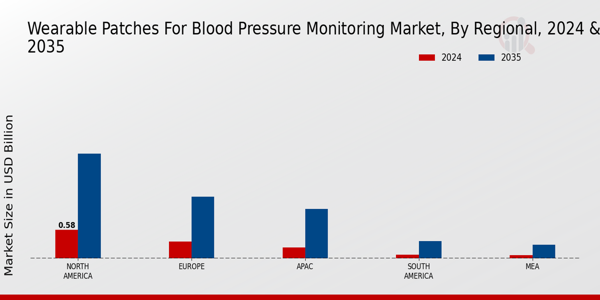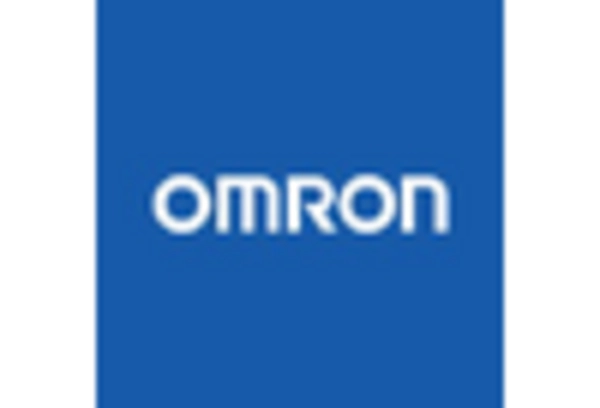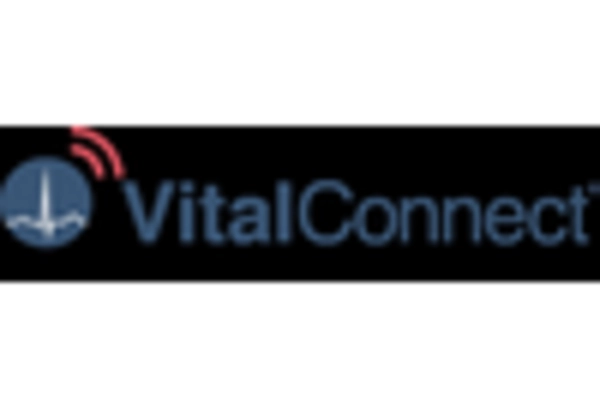Increased Health Awareness
The growing awareness of health and wellness among consumers is a key driver for the Wearable Patches for Blood Pressure Monitoring Market. As individuals become more conscious of their health metrics, the demand for continuous monitoring solutions rises. This trend is particularly evident in populations at risk for hypertension, where proactive management is crucial. Surveys indicate that nearly 70% of adults are interested in using wearable technology to track their health. This heightened awareness is not only fostering a culture of preventive healthcare but also encouraging manufacturers to innovate and improve their offerings. Consequently, the market is likely to see a surge in demand for user-friendly, effective wearable patches that cater to this health-conscious demographic.
Rising Incidence of Hypertension
The increasing prevalence of hypertension worldwide is a significant driver for the Wearable Patches for Blood Pressure Monitoring Market. With an estimated 1.13 billion people affected by hypertension, the need for effective monitoring solutions has never been more critical. This condition is often asymptomatic, making regular monitoring essential for early detection and management. The World Health Organization has emphasized the importance of regular blood pressure checks, which has led to a growing acceptance of wearable technology as a viable solution. As healthcare systems seek to reduce the burden of hypertension-related complications, the demand for wearable patches is expected to rise. This trend indicates that the market will likely expand as more individuals seek convenient and reliable methods to monitor their blood pressure.
Aging Population and Chronic Diseases
The aging population is a crucial factor influencing the Wearable Patches for Blood Pressure Monitoring Market. As individuals age, the risk of developing chronic diseases, including hypertension, increases significantly. The demographic shift towards an older population is prompting healthcare systems to seek innovative solutions for managing chronic conditions. Wearable patches offer a non-invasive, user-friendly method for continuous blood pressure monitoring, which is particularly appealing to older adults who may struggle with traditional monitoring methods. Projections suggest that by 2030, the number of people aged 60 and older will reach 1.4 billion, further driving the demand for wearable health technologies. This demographic trend indicates that the market for wearable patches will likely expand as healthcare providers and patients alike recognize the benefits of continuous monitoring in managing chronic diseases.
Integration with Digital Health Platforms
The integration of wearable patches with digital health platforms is transforming the Wearable Patches for Blood Pressure Monitoring Market. This integration allows for comprehensive health data management, enabling users to track their blood pressure alongside other vital health metrics. Platforms that aggregate data from various sources provide users with a holistic view of their health, which can lead to better health outcomes. Moreover, healthcare providers can utilize this data for more informed decision-making and personalized treatment plans. As of 2025, it is estimated that over 50% of wearable device users will engage with digital health platforms, indicating a shift towards interconnected health ecosystems. This trend suggests that the synergy between wearable technology and digital health will likely enhance user engagement and adherence to monitoring regimens.
Technological Advancements in Wearable Patches
The Wearable Patches for Blood Pressure Monitoring Market is experiencing rapid technological advancements that enhance the accuracy and functionality of these devices. Innovations in sensor technology, materials, and data analytics are driving the development of more sophisticated patches. For instance, the integration of micro-electromechanical systems (MEMS) allows for real-time monitoring of blood pressure with minimal discomfort. Furthermore, advancements in wireless communication enable seamless data transfer to smartphones and healthcare providers, facilitating timely interventions. According to recent estimates, the market for wearable health devices is projected to reach USD 60 billion by 2025, with a significant portion attributed to blood pressure monitoring solutions. This trend suggests that as technology continues to evolve, the adoption of wearable patches will likely increase, making them a vital component of personal health management.


















Leave a Comment